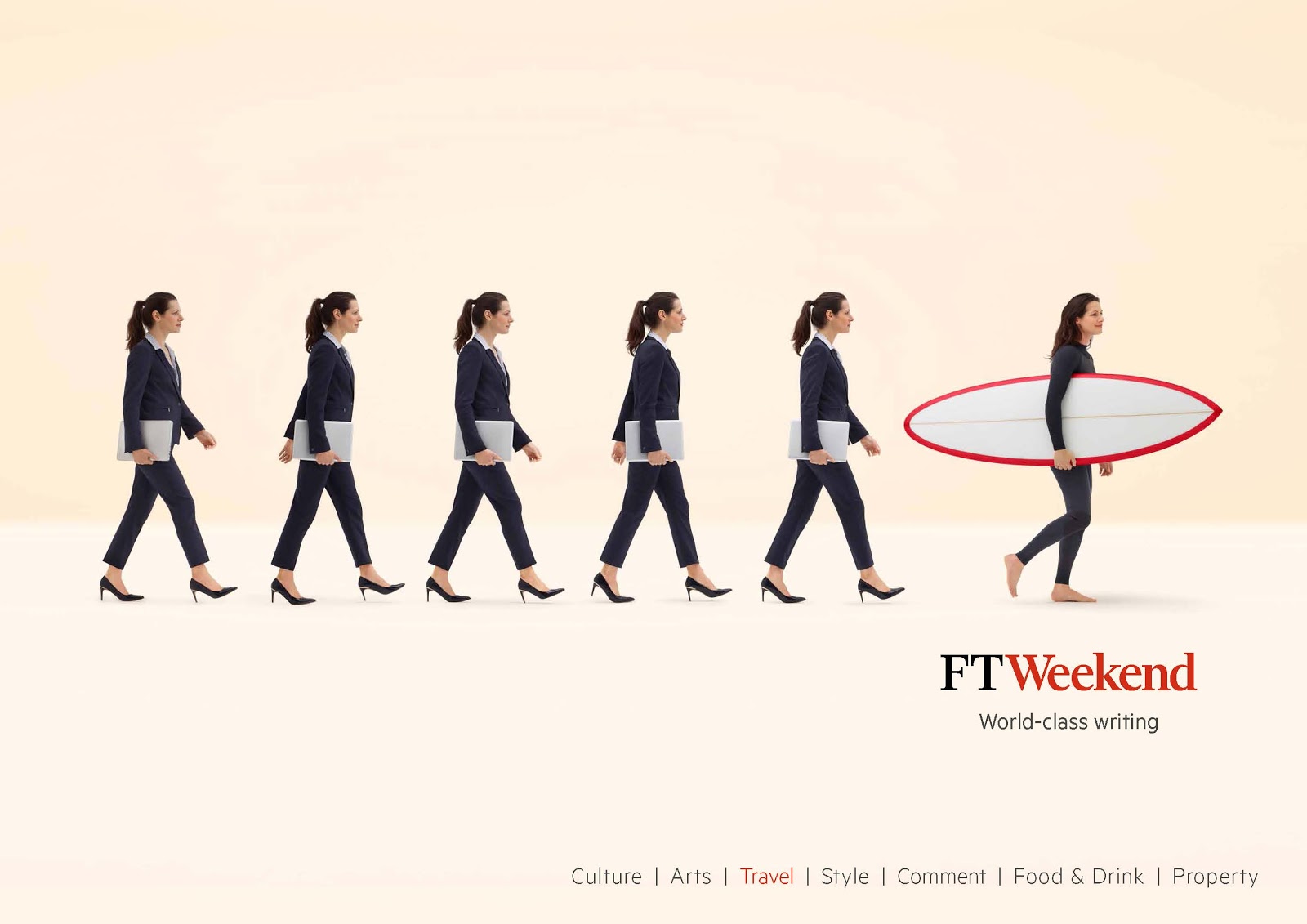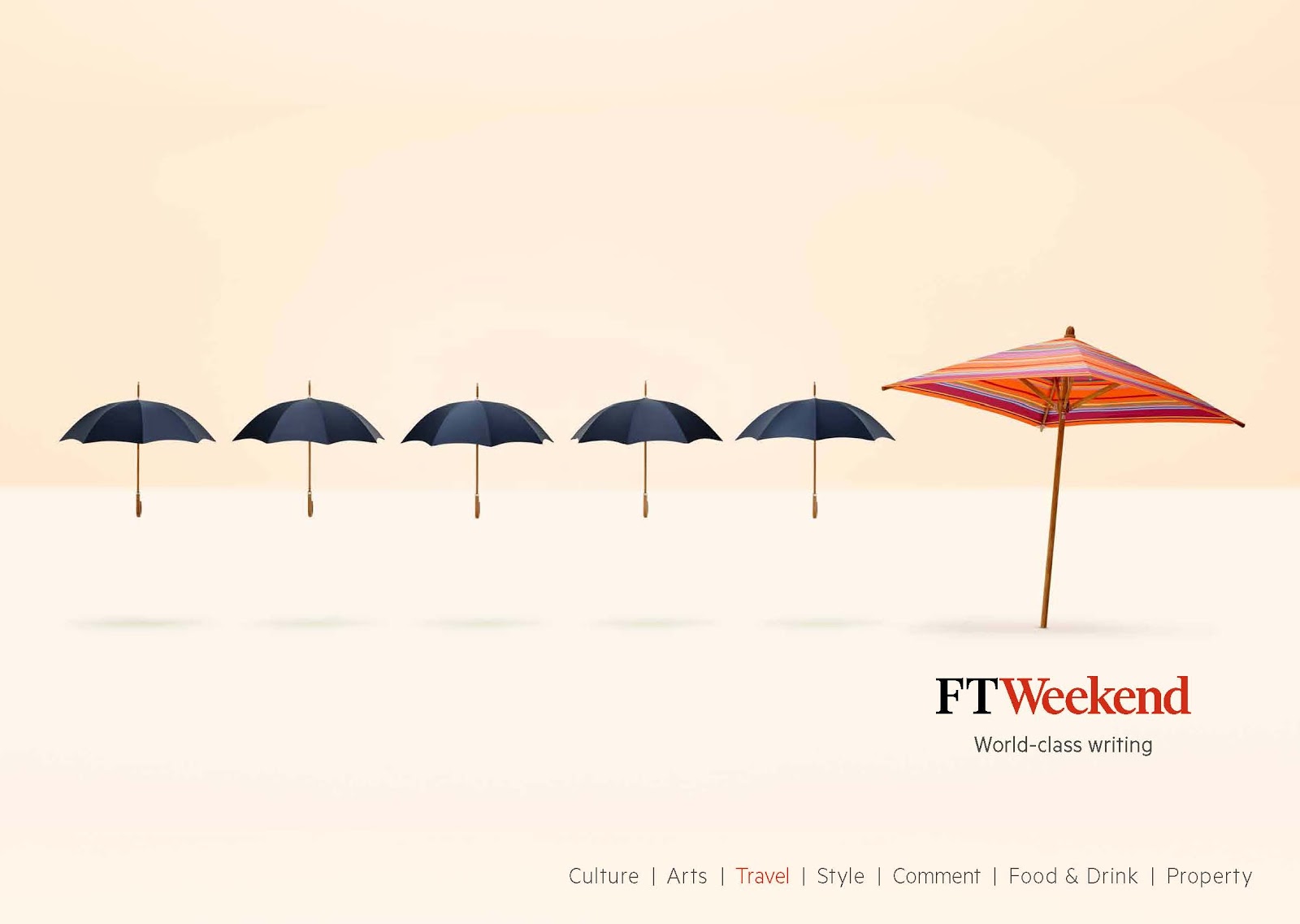The peach color is still there, but the Financial Times introduced a refreshed FT Weekend last week, complete with a global brand marketing push and a new print and digital subscription bundle that combines premium digital access to FT.com and delivery of the Saturday newspaper.
Notice that the overall mood is a total relaxation experience, the ultimate lean back reading experience for print.


I am interested in this development because it follows a trend for major newspaper brands globally to pay special attention (one could call it tender loving care) to their weekend editions. I am one of those who think that when print ceases to exist Monday through Friday, the weekend editions in print will remain. In fact, they may become stronger and with more supplements.
In the FT’s marketing department own words:
“The campaign is aimed at a growing readership who favour the immersive experience of print on the weekend while remaining highly engaged with digital journalism during the week.”
And FT Weekend editor Alec Russell added that readers like the fact that the FT Weekend appears on Saturday. As one reader put it “ I then have two days to indulge and enjoy it.”
That’s the idea, a long, lean back experience for which readers do not have time during the busy days of the week.
What the “refresh” includes:
The refresh includes a number of editorial changes:
- A redesigned front page which highlights the variety of journalism in FT Weekend .
- A redesigned FT Magazine, introducing a new big interview, a weekly page with FT journalists delivering ‘how to’ tips to readers (also available as a video online), and a new feature with well known figures recommending their favorite food and shops around the world.
- New content, such as a new weekly satirical column by political writer Henry Mance, a new column by Tim Harford, the FT’s Undercover Economist and a
new global column by Merryn Somerset Webb, FT’s Personal Finance commentator, in addition to her FT Money column. - There is also a new tech notebook, Techland: Notes from the digital bunker, to be launched next month.
- A new FT Weekend video channel, FT Life, to launch in April.
- An expanded events schedule including events in Los Angeles, Hong Kong and Paris .
Marketing: Brand Films Feature FT Readers
The FT also this week launched a series of brand films featuring FT readers from around the globe. Developed over several months and filmed in multiple countries, the vignettes seek to capture the importance of FT journalism in people’s everyday lives.
The series forms part of an integrated campaign across TV and online, planned by Guerillascope, which will see the ads appear on Sky News, Channel 4, Discovery, National Geographic, Bloomberg TV, BBC Online, Monocle’s film section, Taxi TV in London, and more.
And, at at time when truth, credibility and authenticity are so important to newspapers, the FT’s latest marketing campaign profiles real readers that, according to FT, say that “ they trust what is published in the FT to be impartial, accurate and important.”
Watch the full series on about.ft.com
Algorithms as content traffic cops
My recently published piece in Columbia Journalism Review:
http://www.cjr.org/analysis/news-algorithm-homepage.php
Algorithms set the agenda based on a series of criteria—just like human agenda setters have done through the ages—but perhaps with greater accuracy, since algorithms can react to how users behave, how long they stay reading, when they read, etc. At Aftenposten, this is already working well, and two users who live next door to each other may get two different set of stories on their homepage: Susan, who likes fitness and cooking, gets items in those categories; while Paul, her neighbor, may get a heavier dose of politics and sports news. A good thing.
Virtual Reality and the News
Here is an interesting piece about “walking into the news” via Virtual Reality. This is bound to happen soon for many newspapers and magazines.
Highlight:
From Deniz Ergurel—
“VR is a whole new universe where you can place the reader inside the news content, either through 3D computer-generated interactivity or 360-degree imagery.”
http://www.comstocksmag.com/web-only/local-business-aims-transform-news
Speaking Engagements Coming Up
I will be speaking at these events in the weeks ahead:
Webinar for Crowdynews: open to all
March 29, 9 a.m. EST
The brief: What trends should every publisher embrace in 2017? According to Dr. Mario Garcia, top-of-mind should include digital storytelling, email newsletters, and sponsored content.
“Mario Garcia, world renown storyteller, editorial designer, and digital strategy consultant, will share practical steps news organizations can embrace to offset the disruptive forces rocking the news industry. During this 60-minute webinar, Mario will introduce a concept and then open the floor for a discussion on implementation and best practices sharing stories of those who are realizing success.”
In this webinar, Dr. Garcia will cover how to:
1) Go where your readers are: mobile. How do you create a more visually compelling and interactive experience for your mobile users while facing the challenge of a smaller screen size?
2) Be the source of their news – starting with their inbox every morning. How do you create a personalised, informative, and indispensable newsletter for your audience?
3) Serve your readers with high quality, non-obstructive ads or face ad blockers. How do you organize your newsroom to offer sponsored content while not compromising editorial integrity?
To register, go here:
https://attendee.gotowebinar.com/register/5146625194690261761
VOZ Media Conference
April 6
Vienna, Austria
I will be the keynote speaker for this event, my presentation titled The important role of print in the digital age. This presentation presents a state of the media today, with emphasis on how we tell stories visually on mobile devices, the role of print and the importance of email newsletters and sponsored content to find new ways of promoting content and monetizing your operation.
For more information: http://www.voez.at/b2039m10